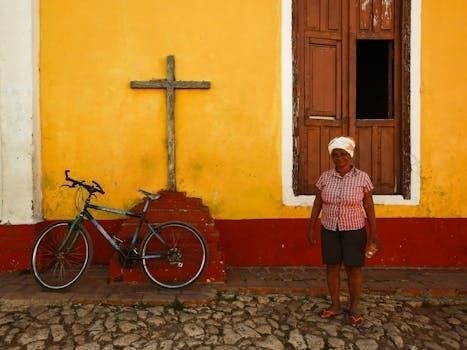Cross stitch charts are the blueprints for your needlework, using grids where each square represents a stitch. These charts employ symbols to indicate color, and guide stitch placement, forming a visual guide.
Understanding the Basics of Cross Stitch Charts
Cross stitch charts are essentially visual maps for creating designs with thread. They use a grid system where each square corresponds to a single stitch on the fabric. These charts guide you by using symbols, often combined with colors, indicating which colored floss you should use and where each stitch should be placed. The grid on the chart mirrors the weave of your fabric. Darker grid lines in 10×10 sections aid in counting and navigation. Every symbol on the chart is paired with a specific color of thread in a color key. These charts are essential for cross stitch patterns and help to keep track of your work. Understanding these basics is crucial for any cross stitch project.
Decoding Cross Stitch Symbols
Cross stitch charts use symbols to represent different thread colors and stitch types. Understanding these symbols is essential for correctly interpreting and executing a design.
Commonly Used Symbols in Cross Stitch
Cross stitch charts utilize a variety of symbols, each corresponding to a specific color of embroidery floss. These symbols, often found within the grid squares, act as a visual language guiding your stitching. Common symbols include simple shapes like circles, squares, and triangles, as well as letters and numbers. Each unique symbol is paired with a specific color in a color key, usually displayed alongside the chart. The color key helps you to accurately choose the correct floss for every stitch, ensuring the final project matches the intended design. Many charts also use solid or open symbols, or symbols with specific patterns inside them to represent different colours. These symbols are essential for accurately reproducing the design.
Symbols Representing Different Stitch Types
Beyond color, symbols in cross stitch charts also represent different stitch types. While a standard cross stitch is the most common, other stitches such as backstitches, half stitches, and French knots often appear. Backstitches, indicated by lines, add outlines and details. Half stitches, usually a diagonal line, create shading and subtle changes. French knots, represented by small circles or dots, add texture. Each of these specialized stitches is assigned a unique symbol on the chart, usually distinct from the color symbols. The symbol key will clarify which symbol corresponds to what stitch type, which is vital for accurately completing a complex design. Recognizing these symbols allows stitchers to create the full range of effects intended by the pattern designer.
Reading a Cross Stitch Pattern
Reading a cross stitch pattern involves understanding the grid system, where each square corresponds to a stitch on your fabric. Symbols within the grid indicate stitch placement.
The Grid System and Fabric Correspondence
The grid on a cross stitch chart is directly related to the weave of your fabric, particularly Aida cloth. Each square on the chart represents one stitch, which corresponds to one square on the fabric. This means that a symbol within a square on the chart indicates where to make a stitch on your fabric. The chart mirrors your fabric, allowing you to easily transfer the design. This direct correspondence makes it easier to track your progress, ensuring accurate representation of the pattern, and helps maintain proper proportions. Understanding this relationship is fundamental to successful cross stitching, as it serves as a visual guide for the entire project. Some charts use thicker lines to denote 10-by-10 sections, aiding in counting and preventing errors.
Identifying Stitch Placement Using Symbols
Each symbol on a cross stitch chart not only specifies a color, but also indicates the precise location of each stitch. The symbols are placed within the grid squares, showing you where to make a stitch on your fabric. If a square contains a symbol, it means you need to work a stitch in that corresponding spot on your fabric. These symbols guide you across the pattern, ensuring that each stitch is made correctly. No symbol in a square usually means no stitch is needed there. By carefully following the placement of the symbols, you can accurately recreate the design on your chosen fabric, keeping track of your progress, and minimizing errors. Symbols are a vital part of the chart, working as a visual guide for stitch placement.

Using the Color Key
The color key is essential, providing a legend that matches each symbol on the chart to a specific floss color, ensuring correct color usage throughout your project.
Matching Symbols to Floss Colors
Each symbol on a cross stitch chart corresponds to a specific color of embroidery floss, and this relationship is detailed in the color key. This key acts as a vital reference, listing each symbol and the corresponding thread color number, typically from brands like DMC. When you encounter a symbol on the chart, you must refer to the key to determine which color floss to use for that stitch. This ensures accuracy and consistency in the final design. The color key may also include information about the number of strands of floss to use. Some patterns use a combination of colors and symbols, while others use symbols only. This matching process is a fundamental part of cross stitching, allowing you to recreate intricate designs correctly. Color keys are an essential part of any pattern.
Understanding the Color Chart
The color chart is a crucial component of a cross stitch pattern, providing a visual reference for the design’s color distribution. Typically presented as a grid, it displays a miniature version of the finished project, with each square filled with the color that corresponds to the symbols on the main chart. This chart helps you understand how the colors will blend together and the overall appearance of the design. It also serves as a quick reference to identify the placement of different color blocks. Some color charts will include symbols to further clarify where to place each stitch. The color chart is used alongside the main pattern and the color key to help you produce a correct design. It is basically a graph full of squares that are colored in to show you where each color goes in the pattern.

Advanced Stitch Techniques
Beyond basic cross stitches, advanced techniques include half stitches, backstitches, blending, and tweeding. These add texture and depth, enhancing the final design of the pattern.
Recognizing Half Stitches and Backstitches
Half stitches, often depicted as a diagonal line within a square, are used to create shading and subtle transitions in a cross-stitch design. Unlike full cross stitches, they only cover half of the grid square. Backstitches, represented by straight lines on the chart, outline shapes and add details, defining the edges of elements or creating lettering. These stitches are essential for adding definition and depth to a cross-stitch project. They are typically worked after all the cross stitches are done. Understanding the symbols for half and backstitches is crucial for completing projects with varying textures and intricate designs. These stitches are not always present in the project, but when they are they are important.
Understanding Blending and Tweeding
Blending, also known as tweeding, involves combining two or more different colored threads in the same needle to achieve a subtle, mixed effect. This technique is used to create smoother color transitions and add depth to your cross-stitch project. Instead of using a single color, you thread your needle with strands of different colors, typically one strand of each. This allows you to produce a variegated look that enhances the visual texture. The chart won’t always explicitly show the need for blending, it’s often a technique that is described in the pattern instructions. The key is to use the right combination of colors;

Tips for Beginners
Starting in the middle of the pattern is helpful, and keeping track of your place minimizes errors. Using a pattern reader can be very helpful.
Starting in the Middle of the Pattern
When beginning a cross-stitch project, it’s beneficial to start stitching in the center of the design. Most charts have arrows indicating the center. To find the center of your fabric, fold it in half both horizontally and vertically, then mark the spot with a pen or pencil. Another method to locate the center is by using a ruler and a pen or pencil. Starting in the middle helps ensure your design is properly positioned on the fabric and prevents running out of space on one side. This method is especially useful for beginners to maintain symmetry and balance throughout the stitching process;
Keeping Track of Your Place
Maintaining your position on a cross-stitch chart is essential for accurate stitching. Charts use grids where each square corresponds to a stitch. To avoid mistakes, use tools like highlighters or a pencil to mark completed sections. Some stitchers use special PDF readers that allow symbol highlighting. Following a systematic approach, such as working row by row, helps in keeping track of your position. This method minimizes errors and accelerates the stitching process. Whether you are working on a small or a large project, keeping your place and knowing what to stitch next is important to help make sure the stitching is easier and faster.

Additional Information
Beyond basic stitches, cross stitch includes special stitches. Complex patterns can also pose challenges. Resources are available to help, and guides can help stitchers with difficulties.
Special Stitches and Their Symbols
Cross stitch charts often include more than just the standard cross stitch. You may encounter symbols for backstitches, which are typically represented by straight lines on the chart, used for outlining and adding detail. French knots, indicated by a dot or a small circle, are used for texture. Half stitches, sometimes called squashed stitches, appear as a diagonal line within a square, creating different effects. These variations add depth and complexity to the design. Understanding these symbols is key to completing patterns with diverse textures and intricate details. These stitches, each with its own symbol, expand the creative possibilities within cross stitch.
Dealing with Complex Patterns
Complex cross stitch patterns can seem daunting, but with a few strategies, they become manageable. Start by focusing on one section at a time, perhaps a 10×10 grid area, as darker lines on charts often indicate these sections. Use a highlighter or pen to mark off completed sections on your chart to keep track of your progress and avoid confusion. Employ a pattern reader tool if available to make this process easier. Be patient and double-check your stitches to minimize errors. Break the pattern down into smaller parts, and tackle one at a time. These steps make even the most intricate designs achievable.
